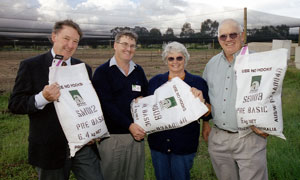|
October 16, 2003
Western
Australian producers can look forward to two new subterranean
clovers, expected to boost cropping and livestock industries
through greater productivity and nitrogen inputs.
 The
Department of Agriculture today unveiled its new clovers
Izmir and Coolamon at the Medina Research Station
Field Day. The
Department of Agriculture today unveiled its new clovers
Izmir and Coolamon at the Medina Research Station
Field Day.
Director
General Graeme Robertson said seed of both varieties was
currently being increased by licencees and commercial seed would
be available to growers in 2005.
Dr Robertson
said the new pastures were selected as part of the National
Annual Pasture Legume Improvement Program with funding from the
Grains Research and Development Corporation and Australian Wool
Innovation Ltd.
“Izmir and
Coolamon were evaluated at more than 20 trial sites across
southern Australia over a seven year period,” Dr Robertson said.
“Izmir is
suited to low rainfall areas and is estimated to increase
livestock production by $7-$15/ha and increase the value of
nitrogen inputs by $6-$10/ha over existing cultivars.
“In medium to
high rainfall areas, the estimates for Coolamon show an increase
in livestock production of $10-$18/ha and increase in the value
of nitrogen input of $8-$12/ha over existing cultivars.”
Research
officer Phil Nichols said
Izmir
was originally collected as a pasture sample from
Izmir
province in Turkey.
He said it
would be a direct replacement for the variety Nungarin for
sowing in areas of the wheatbelt with less than 375mm of annual
rainfall.
“Izmir is very
early flowering (similar to Nungarin) but its higher
hardseededness, coupled with good seed production, results in
greater persistence in cropping rotations and fewer seed losses
following false breaks to the season,” Mr Nichols said.
“Over all
measurements,
Izmir
produced 10 per cent more winter herbage and 7 per cent more
spring herbage than Nungarin.”
Mr Nichols
said the release of
Izmir
would help satisfy the demand for a more persistent subterranean
clover for low rainfall areas where cropping frequency was
high.
He said it
would enable farmers to improve their pastures to take advantage
of stronger wool prices.
Marketing
licenses for
Izmir
have been awarded to Ballard Seeds and to a consortium of
Premier Seeds, Irwin Hunter Seeds, AusWest Seeds and Stephen
Pasture Seeds.
Mr Nichols
said Coolamon was a mid-season replacement for Junee with
improved disease resistance, herbage production and persistence.
“Coolamon has
resistance to both known races of clover scorch. Its resistance
to Race 2 gives it a distinct advantage over Junee, which is
currently failing on the Esperance sandplain due to its
susceptibility to the disease,” Mr Nichols said.
“Coolamon and
Izmir both have low oestrogen levels and will not lead to sheep
infertility.”
Mr Nichols
said Coolamon had performed well in all States. When averaged
across all sites, it produced 10 per cent more herbage in
winter, 14 per cent more herbage in spring, four per cent more
seed and had 11 per cent higher seedling densities than Junee.
“Coolamon is
suited for use on well-drained soils in areas with more than 500
mm annual rainfall and has a potential area of use across
Australia of 4.5 million hectares,” he said.
“It is
moderately hardseeded and well suited to permanent pasture and
phase farming systems, and also to ley farming systems with
infrequent cropping.”
The marketing
license for Coolamon has been awarded to a consortium of Premier
Seeds, Irwin Hunter Seeds, AusWest Seeds and Stephen Pasture
Seeds. |